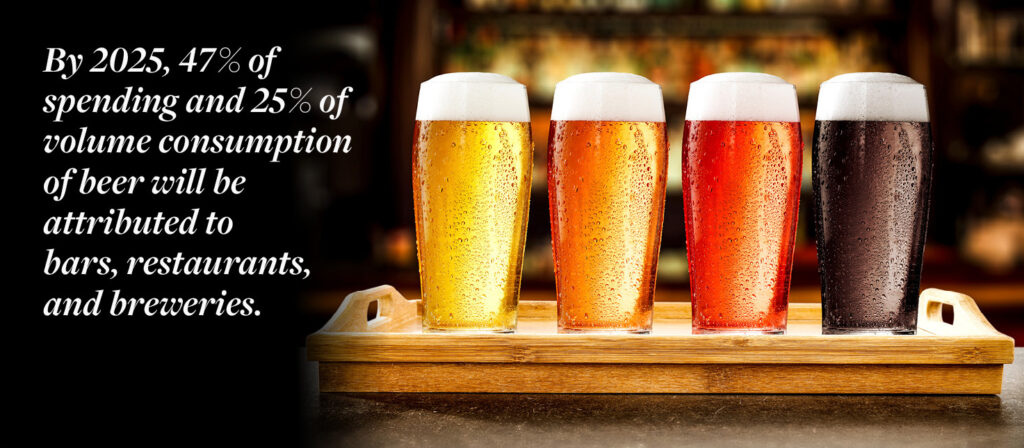
By: Gerald Dlubala
Strolling into Townsend, Tennessee, on the peaceful side of the Smokies, you can’t help but notice the relaxed atmosphere. Located at the base of the Smoky Mountains, Townsend is an outdoor activity hotbed featuring some of the best hiking, mountain biking and camping you’ll find. Along the main parkway, you’ll also come across a unique, welcoming, 4,000-square-foot glass-enclosed building with a back patio with games and outdoor seating. Look a little closer, and you’ll recognize the shimmer of distilling and brewing equipment gleaming through the massive windows. This is the home of Company Distilling, and we’re all invited inside.
Jeff Arnett, the Master Distiller of Company Distilling, was with Jack Daniels for 20 years, 12 of those as a master distiller. Although demanding, it was a dream job, and he loved the people he worked with. But after expanding the Jack Daniels portfolio from three to 11 products and winning “Master Distiller of the Year” in 2017, Arnett felt the urge to build his own brand from the ground up. At Townsend’s annual Grains and Grits Festival, a yearly event on the first Saturday of November featuring locally produced spirits and food, that urge began to pick up steam.

Great Location & Great People Produce Great Products
“I thought Townsend was a beautiful location,” said Arnett. “I knew the people there, and I knew they were interested in having a distillery in Blount
County. I knew that you need great people to produce a great product. After talking with other distillers, they all pushed their chips in, so we had distillers who could make whiskey, gin and beer. We also had GM experience within the group, so as friends with a common goal, we decided to take a leap of faith and create Company Distilling. We’re not the first distillery in Blount County, just the first legal one.”
“The name for Company Distilling was inspired by the pandemic when we all had to rethink how we were gathering and how we could get together with our families,” said Arnett. “We couldn’t just go to restaurants or bars and order what we wanted anymore. We entertained and gathered in our homes with those we held dearest. They were moments to be cherished and shared, so we wanted to make a product that reflected that sentiment here at Company Distilling. When I was little, my mom told me to clean my room and shower when company came. You put your best foot forward for the guests that come to your home. We made a product that, once discovered, you want to share with your closest friends and family. It was natural that we call ourselves Company Distilling to reflect that attitude. It became our inspiration.”
Arnett wanted to explore wood finishing. He started doing it at Jack Daniels on a small-scale distiller series. One of the eight new products he brought into Jack Daniels’ portfolio was the No. 27 Gold. It was double-barreled and double-mellowed using maple barrels and charcoal, along with the original white oak barrel. Arnett said that it was one of the best products that they made. However, the maple barrels tended to leak more, losing more liquid and driving costs up. The process needed improving. Arnett worked to modify the process, and after several years of development, it has created additional opportunities to replicate a double-barreling method using non-traditional barrel woods. This proprietary process allows Arnett to offer products containing a new and natural range of character and flavor without additional additives.
“As a distiller, you want to work with water, grains, yeast, oak barrels and woods as much as possible to create nuance and character,” said Arnett. “There are three native forms of American whiskey known to be created in the United States: Tennessee whiskey, bourbon whiskey and rye whiskey. We wanted to respect and reflect that history with three successful, wood-finished products and offer flights for comparison. Our first product was our straight bourbon whiskey finished with maple, and now we offer our straight rye whiskey finished with cherrywood and our straight Tennessee whiskey finished with applewood. These perfectly demonstrate how our natural, wood finishing process builds unique character and flavor enhancements.”
Company Products for All Tastes and Occasions
Company Distilling also produces the Ace Gap brand of flavored spirits. Although Company’s brand is not about mason jar moonshine, East Tennessee is a hotbed for it. With Ace Gap flavored spirits, Company stays true to the Smokey Mountains history and Tennessee’s moonshine roots.
“Before forming the Smokey Mountains National Park, loggers were cutting trees in what is now known as the Ace Gap Trail,” said Arnett. “There was a still out there, and the loggers would sit around, play cards and drink their shine. To honor that, the GPS coordinates for Ace Gap are on the back of the Ace Gap bottles. Our flavored spirits are available in eight flavors and, more importantly, are very cocktail-friendly in contrast to true moonshine. When Townsend is full, there are about 15,000 people in the campgrounds, including many families. We wanted to offer a product that allowed the campers to make a simple cocktail in the campground with ingredients they may already have or could easily pick up at the market, like lemonade, limeade, cream, tea, milk or whatever. Our flavored spirits taste like what the labels say they taste like, without the traditional corn nose and note of traditional moonshine.”
In addition to the Townsend location, Company Distilling has a smaller site in Thompson’s Station, south of Nashville. The Thompson’s Station location distills their Ghost Rail Gin, which won “Best Gin” at the 2021 Ascot Awards.
Company Distilling is a true brewstillery, offering six beers brewed in-house and on tap for visitors, thirsty campers and parched mountain bikers. For those that prefer a cold, refreshing, locally made, great beer, choices include Fest Bier, Kolsch, American Lager, Black Rye IPA, American IPA and a New England IPA.
“We took out the traditional mash cooker and fermenter system and replaced it with Deutsche equipment to make 3 ½-barrel batches of beer,” said Arnett. “You have to make beer first and then distill it into whiskey anyway. The two processes are pretty well tied together, but we included lagering tanks, a boiling kettle, the lauter tun and everything you need to get grain solids out and pasteurize and make high-quality beer.”
You’re Not Just a Visitor, You’re Company
Walking into Company Distilling in Townsend, you are immediately taken by the massive windows looking into the production area and providing spectacular views of the surrounding landscape and mountains. Live music enhances the experience on weekends. Of Company Distilling’s 4,000 square feet, one quarter of it is production space viewable through large glass panels. Here, you’ll likely spot Arnett and his team hard at work getting things just right. Both locations feature tasting rooms, bottle shops and cocktail menus.
Along with regular tastings, visitors can fill a bottle and enjoy a premium tasting with the master distiller experience at the Townsend location. A small service kitchen, the Amico Deli, provides hot and cold food. Having had lunch and experiencing the exceptional folks and customer service at the Townsend location, I can tell you that they really do treat everyone as welcome and cherished company, and the food is on par with their handcrafted spirits and beer.
“We want to share our success with everyone else around here because, ultimately, that’s what it is all about,” said Arnett. “Townsend has a lot of green space, where people come to tube the river, mountain bike and hike. We cater to outdoor enthusiasts by making our distillery a glass box that connects to the outdoor landscape and beauty. Townsend experiences precipitation that gets pushed here from the mountains an average of 100 days a year, so connecting with the outdoors is important even on those less-than-perfect days. We create our spirits thoughtfully on the peaceful side of the Smokies so our customers can enjoy them surrounded by spruce, fir and hardwood. We make our bourbon with a proprietary, toasted maple wood finishing process. We take hard sugar maple and toast it, caramelizing the natural sugars in the wood. We reduce the maple for entry into the oak barrel and then pull periodic samples to determine when the liquid is ready for bottling. Our products are ready when they’re ready, determined only by taste and time.”
Looking Ahead
“Besides our two locations, we have a 30+-acre property in Alcoa, near Knoxville airport,” said Arnett. “It’s an old brick plant that made the brick for the Alcoa Aluminum plant. It would be able to hold up to 10,000 barrels. We hope to build our main distillery adjacent to it if we can purchase an adjoining five-acre tract of land. We’re working on it. Until then, it’ll be another year or so for us to have our main facility up and running.”
Arnett tells Beverage Master Magazine that he plans to develop a new product yearly. The release date will coincide with Townsend’s annual Grains to Grits Festival, when Townsend hosts 1,000-1,500 spirits lovers ready to experience new and innovative products.
Enjoying the Work Makes it Worthwhile
“It’s been a slow process, and we’re pushing it uphill, making progress,” said Arnett. “It’s good to see. Distilling is a lot of work, but it’s enjoyable work. I’m super hands-on right now, still toasting my own wood with a proprietary process. You have to love and do what you do for the right reasons. Townsend was the first facility we built, with the new build being in the same location with the same grandfathered-in footprint. All our town has is electricity and septic, so we won’t build a national brand out of here. But we are close to Cades Cove, the most visited spot within the most visited national park. Our location allows visitors to get to know who we are. We have nearly two million cars passing us annually and are within a day’s drive of half the U.S. population. We directly distribute to six states and look to double that soon. Others can get our products through Seelbach’s online.”
Arnett says that Company Distilling tests and tunes its products before moving them into the recognizable Company signature bottle. Their Cherrywood Finished Rye won double platinum this year and entered the Company lineup. The Applewood Finished Tennessee Whiskey was released on International Tennessee Whiskey Day, May 21, commemorating the day Tennessee repealed prohibition in 1937. Arnett said they lost out on the award cycle by holding it back. But because the product has been so welcomed and is now one of their most popular, it was also moved into the Company lineup, fulfilling Arnett’s initial goal of offering wood-finished versions of the first three spirits made in the U.S. In addition to the tasting flights and master distiller experience, Arnett will begin hosting whiskey dinners and working to get his products available in nearby restaurants and country clubs.
Take it from me: visiting is a must if you’re anywhere within reach of Company Distilling. After all, you’re always invited because you’re company.
Company Distilling
8351 TN-73, Townsend, TN 37882
www.companydistilling.com
(865) 366-4360











